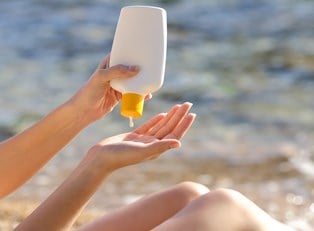When trying to decide which sunscreen is best for your skin, it can be very confusing to understand all of the jargon associated with the different types. UV, SPF, organic, physical, chemical, and broad-spectrum are all terms that are used to describe various types of sunscreens. Understanding how these definitions affect the effectiveness of sunscreen can be helpful when you are searching for the right product for you.
Physical Sunscreen
Physical sunscreen protects your skin by blocking or deflecting the sun's harmful rays. This type of sunscreen is also referred to as "inorganic." It usually contains titanium dioxide or zinc oxide. Though zinc oxide is typically fine with delicate skin, titanium dioxide can be harsh for some skin types. If the sunblock only contains titanium dioxide, then it will only protect against UVB rays and some UVA rays. However, zinc oxide will protect against the full spectrum of both UVB and UVA.
Even though the texture of physical sunscreen can be unappealing, since it is thick and usually opaque in color, it will start working immediately upon application. However, it will usually leave a white tint to your skin and tends to rub off easily, resulting in the need for multiple applications.
Chemical Sunscreen
Chemical sunscreen is also referred to as "organic." Unlike physical sunscreen, chemical sunscreen works by absorbing the sun's rays. Sometimes, chemical filters will scatter the sun's rays, but most of the time they will simply be absorbed. Normally, the chemicals that are included in chemical sunscreen are octylcrylene, avobenzone, octinoxate, oxybenzone, homosalate, helioplex, 4-MBC, mexoryl, tinosorb, and uvinul. These chemicals can sometimes be harsh on your skin because chemical filters can cause irritation. If it gets into your eyes for any reason, it can be very painful because it will cause stinging, burning, and watering. In rare cases, it can even cause an allergic reaction.
Chemical sunscreens typically tend to offer more protection against UVB and UVA rays than physical sunscreen, but the exact amount of coverage will depend on which chemical agent(s) are being used in a particular sunscreen and how effective they are specifically. Also, unlike physical sunscreen, chemical sunscreen is generally colorless and odorless. It will stay on your skin for a longer amount of time, but you must wait twenty minutes after application before it is fully effective.
Even knowing all of the differences between physical and chemical sunscreens, it can still be difficult to decide which type of sunscreen is going to work the best with your skin. Chemical sunscreen may offer more protection but is often harsh on your skin. On the other hand, physical sunscreens are more difficult to apply, leave streaks on your skin, and will not last as long.
Because there are so many pros and cons to both physical and chemical types of sunscreen, most sunscreens today will contain both physical and chemical elements and filters. The most important thing to take away is that when choosing a sunscreen, the SPF is not always the best indicator of adequate protection.



